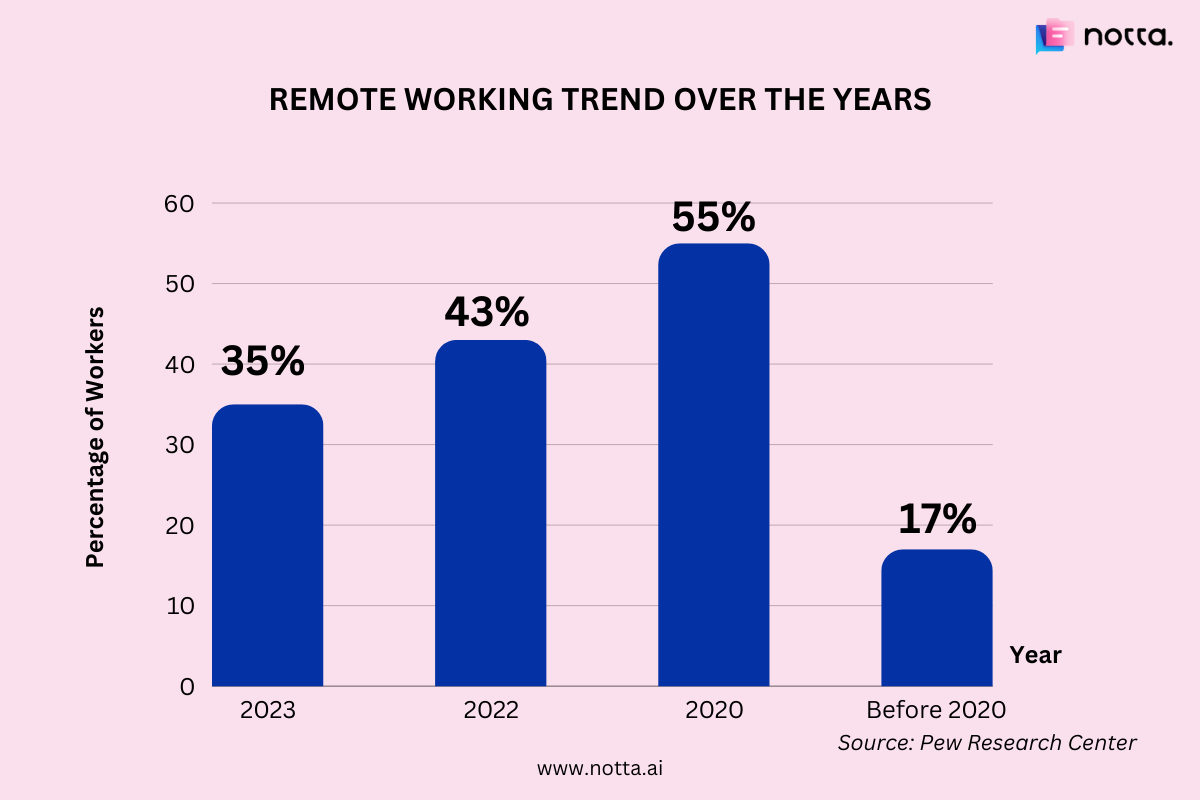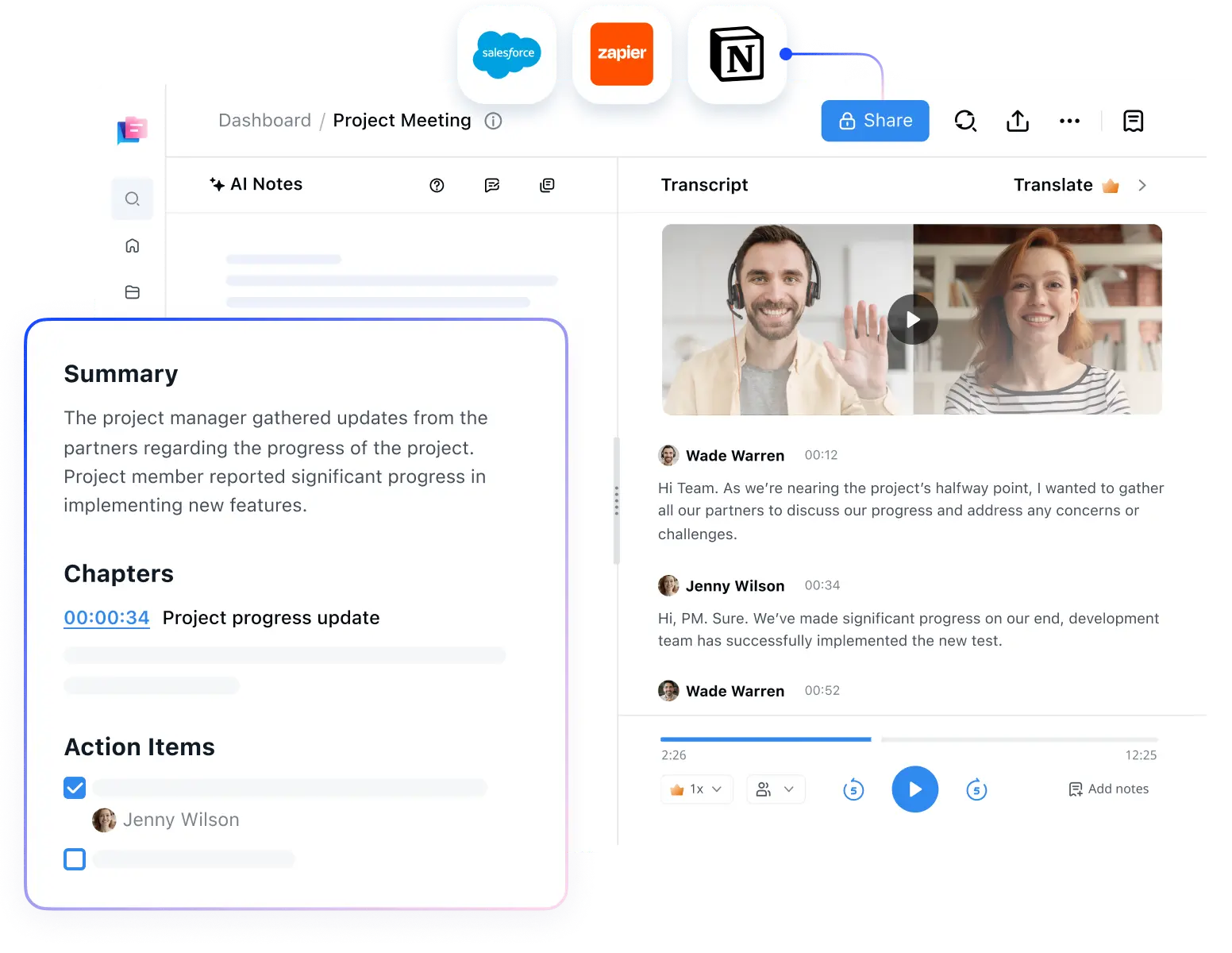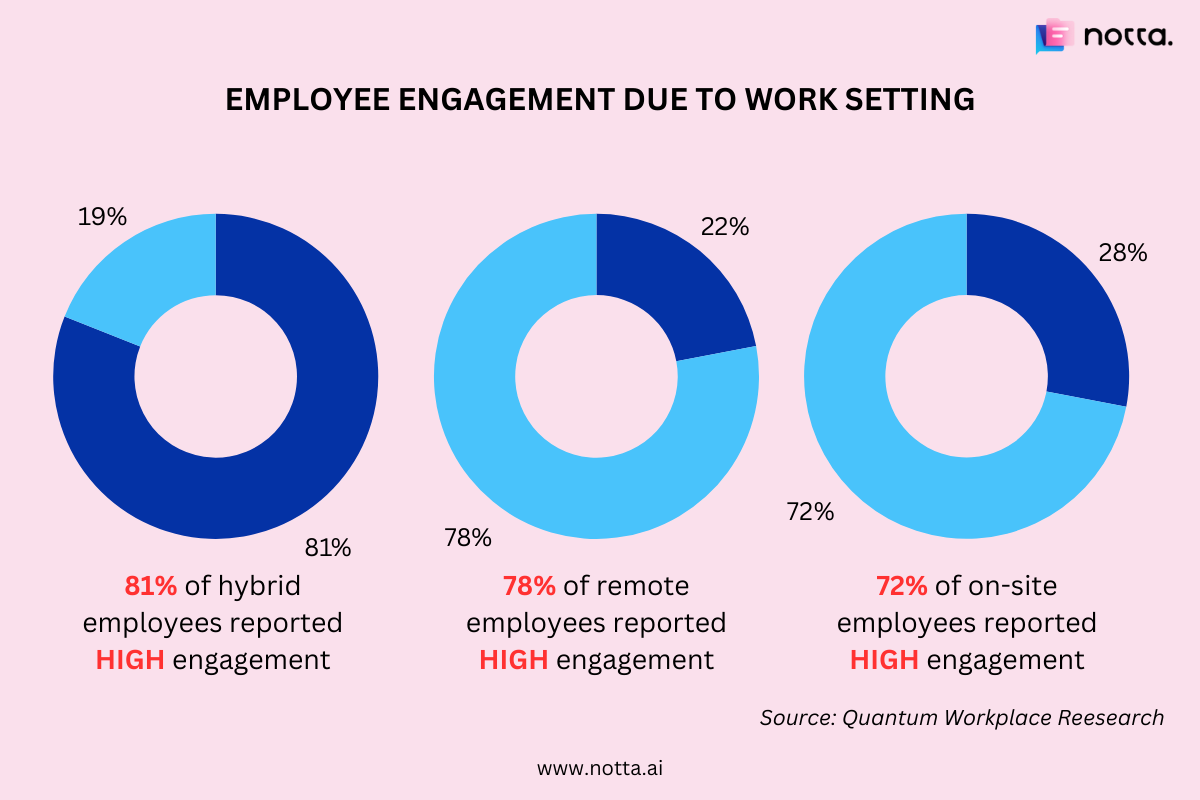
50+ Employee Productivity Stats & Facts in 2025
Record, transcribe and summarize conversations with one click.
The number of hours an employee gives to their company can vary depending on the individual, the company, and the industry. When it comes to employee productivity statistics, the numbers get a bit tricky.
For example, when the pandemic hit, remote work became the norm, but things changed as the world reopened. As a professional, it’s important to stay updated with the employee productivity stats and what’s happening around.
This guide reveals 50+ employee productivity statistics and trends shaping organizational policies in 2025.
Importance of understanding employee productivity
Much of your company’s growth and success depends on how your employees perform. Here are a few key pointers highlighting the importance of understanding employee productivity:
Resource utilization: Knowing that your employees are productive ensures that the resources (money, time, and effort) are used efficiently. It results in cost savings and more streamlined operations.
Identifying bottlenecks: Understanding productivity helps identify the bottlenecks and make improvements accordingly. It potentially boosts overall organizational efficiency.
Goal setting: Knowledge of productivity lets you set realistic and achievable goals. Besides, you can align individual and team goals with respective organizational objectives.
Overview of the small business landscape
Before we dive deep into workplace productivity statistics, here’s a quick market research and key findings:
US labor productivity saw an all-time high at 2.7% in two decades since 2004.
Lesser employee engagement costs U.S. companies around $1.9 trillion in lost productivity in 2023.
Around two-thirds of the employees claim to save around 3.6 hours every week due to automation at work.
Integration of AI results in up to 90% increase in productivity.
42% of the COOs see a shortage of skilled labor as a major productivity challenge in 2024.
87% of workers claim to be more productive working from home.
In 2022, job satisfaction was at an all-time high when 62.3% of employees were satisfied, which increased by 0.4% in 2023.
General workplace productivity statistics
Workplace productivity is rising despite a tough few years of pandemic. Data from many sources shows that companies are finding their feet and focusing on the future. Here’s how:
The current state of employee productivity
US labor productivity saw a period of renewed growth in the past year, which was quite erratic since the start of the pandemic. There was a 2.7% productivity growth in 2023, a 20-year high since 2004, and almost on par with 2.9% growth in 1990, when the country saw a productivity surge. Here are some detailed stats you must know about workplace productivity:
1. 48% of employees reported they are productive less than 75% of the time
Employee engagement doesn’t always result in productivity. Imagine you’re an engaged employee who comes to the office on time, gets involved in interoffice work, collaborates with your colleagues and boss, and speaks up in meetings. But you aren’t wholly productive.
In an online survey of 5000+ adults, Wrike found out that nearly half of them were productive less than 75% of the time, despite some of them being heavily engaged.
2. Low engagement costs around $1.9 trillion per year in lost productivity
In 2024, the outdated way of running a workplace, i.e., forced rankings, annual reviews, and competencies, doesn’t deliver the requisite results. Leaders must gain insight into the wants and needs of employees to build an exceptional workplace.
Gallup’s report revealed that merely 34% of U.S. employees (full-time or part-time) were engaged in work. The actively disengaged employees cost around U.S. $1.9 trillion in lost productivity in 2023. Productivity is rising slowly, but most workers aren’t actively engaged.
3. Superior talent is eight times more productive
It’s incredible how recruiting top talents rockets organizational productivity. A McKinsey study involving businesses reveals that the performance gap rises with job complexity. In highly complex occupations, high performers are 800% more productive.
Major factors influencing productivity
Multiple factors influence workforce productivity in both ways: positively and negatively. Here are a few significant ones:
1. Employee engagement
While disengaged employees cost around 18% of the company’s salary in lost productivity (as per Gallup), employee engagement poses the biggest influence on workplace productivity in 2024. It’s a bit of a tough nut to crack, but we believe with constant efforts, you can reach this feat.
2. Automating Routines
Imagine how much time you save every day when customer orders get updated automatically, and you don’t need to manually input it or update employers through daily meetings. Nearly one-third (77%) of employees in 2023 said to save up to 3.6 hours weekly using such automation at work. It might cost you initially but might benefit you in the long term.
3. Using AI
Artificial Intelligence is one of the major investments companies make to improve their productivity in 2024. 27% of the desk workers say that they’re using AI in 2023 itself, and 90% are more likely to report higher levels of productivity.
4. Labor Shortage
Finding, training, and retaining highly skilled people is a constant hassle that organizations go through every year. As per PwC, 42% of COOs predict labor shortage as a significant productivity challenge in 2024. They need to invest in automation tools and collaboration software to let employees work smarter from anywhere.
Workforce productivity trends
Workforce productivity is on the rise now, with companies primarily focusing on automation and better resource allocation. Technology, millennials, mobility, globalization, etc., are changing the entire employment scene at a faster rate. Some of the common work productivity statistics are as follows:
1. Most employees are looking for a job switch
Do you know how many of your employees are looking for a new job? Well, a report by Monster reveals that around 95% of workers are looking for or plan to look for a new job in 2024. Money is the bigger reason here, with 45% saying the need for a higher income while 40% say there’s no room for improvement.
That’s much higher than what was the figure in 2017. As per Gallup's report in 2017, 51% were searching for new job opportunities.
2. Intimation of technologies like automation and AI
Technological advancements, surging investments, and competition for talent all are pointing towards one thing: AI is and will revolutionize the way business operates.
Companies are thereby looking to exploit its true potential and bolster their overall productivity. As per PwC, around 73% of the US companies have adopted AI in some part of their business, and generative AI is leading the way. One year after ChatGPT hit the market, around 54% of the businesses integrated it into their operations.
3. Remote work
Remote work has primarily gained popularity since the pandemic, and as per Microsoft’s Work Trend Index Special Report, 87% of employees said they are productive when they work from home. Here are a few figures on remote work in the US, as per a Pew Research Center study:
35% of the workers can permanently work from home, which is down from 43% in January 2022 and 55% in October 2020. And before the pandemic, only 17% worked from home five days a week.

41% of the remote workers are on a hybrid setup.
Among hybrid workers who aren’t self-employed, 63% say their employer requires them to work in person for a certain number of days or weeks in a month.
34% of remote workers say they want to work from home all the time.
Employee satisfaction statistics
As a content strategist, I understand the importance of satisfaction and mental peace in the quality of my work. The ideas won’t pop up, and the quality of content drops with decreasing morale when I am not particularly satisfied.
Apparently, I’m not the only one here, so here are some key statistics:
1. Satisfied employees in the US are increasing
A report published by The Conference Board reveals that job satisfaction among workers was at an all-time high in 2022 and is steadily moving upwards. 62.3% of employees were satisfied, making it the highest ever since 1987. The overall job satisfaction amongst US employees increased a modest 0.4% in 2023.
2. Large gender gap in job satisfaction
Amongst various job satisfaction categories, women report lower satisfaction than men across 26 categories. Their satisfaction stood at 60.1%, which is 3.9% lower than men.
3. Black workers experiencing discrimination in the workplace
As per the Pew Research Center, around four in ten black workers have experienced discrimination from their colleagues or employers because of their race or ethnicity. Amongst them, men (48%) experience more discrimination than women (36%).
4. 39% of employees identify themselves with their career
Around 39% of the employees, as per Pew Research Center, say that their job or career is crucial to their identity. Amongst them, 47% belong to higher-income families, while 37% and 36% belong to middle and lower-income families.
5. Flexible work arrangements result in job satisfaction
Employees with hybrid working arrangements are said to demonstrate high job satisfaction compared to full-on remote or premises workers. Although hybrid workers are less satisfied with job security, things are polar opposites in terms of benefits, pay, and access to training opportunities.
6. Upskilling
Businesses are increasingly allocating resources toward streamlining their operations, and the focus is on upskilling and reskilling their workforce. Nearly 71% of the workforce who participated in upskilling agree that it enhanced their satisfaction with work, which potentially boosts overall workplace productivity.
Factors affecting employee productivity
In general, multiple factors such as work environment, training & development, pay structure, and others contribute to employee productivity. However, they can be put into three broad categories: technology, working models, and employee engagement. Let’s find out how:
Technological impact
Technology such as generative AI, automation, time management apps, and others have revolutionized the way we collaborate, communicate, and work. Some of its benefits are as follows:
Increases efficiency: Technology speeds up any process and minimizes errors to bolster overall work efficiency. For example, with Notta AI note-taker, you never miss anything that’s discussed in the meeting. Notta live-records your meeting and transcribes your meeting notes. You can refer to these later when needed.

Better collaboration and communication: With the advent of video conferencing, project management, and instant messaging tools, teams can collaborate on projects, irrespective of their location.
Data analysis: Technology like machine learning algorithms and business intelligence software makes it easier to analyze data and make quick decisions. Besides, data analysis is error-free and accurate.
Let our AI do the heavy lifting - record, transcribe, and summarize meetings - so that you can focus on the conversations.
Remote work and hybrid models
As per Quantum Workplace research, 81% of hybrid employees reported high engagement, which is 78% and 72% for remote and on-site employees, respectively. Other than that, an Upwork study claims that 32.2% of hiring managers saw an increase in productivity with remote work, while 22.5% said productivity has fallen.
 Although remote work is a trend, there are many benefits and challenges involved. Common benefits include
Although remote work is a trend, there are many benefits and challenges involved. Common benefits include
Employees save time and money from commuting.
Remote work can help save the environment. A study by the National Academy of Sciences USA revealed that swapping on-site work to working from home reduces around 58% of carbon footprint.
Working from home helps establish a better work-life balance.
Remote working offers greater schedule, location, and job flexibility.
Employees engage in plenty of digital tools and online platforms and, in turn, upskill themselves.
Common challenges of remote work are as follows:
Working from home often results in longer working hours.
The chances of stress and mental breakdown are higher in remote work.
Work intensification is a staple in this setting.
Employee engagement and well-being
The impact of employee engagement and well-being on productivity is undeniable. Engaged employees take pride in their work, deliver their best, and are willing to share their insights and suggestions. Besides, they stay more with the organization and collaborate more in teams. Here are a few initiatives you can have in place to enhance productivity:
Have a company health policy and foster a culture of personal and work safety
Offer flexible work hours to help employees establish a better work-life balance
Encourage collaborations by hosting some brainstorming sessions
Providing upskilling opportunities to the employees
Pay salaries to the respective employees on time
Global employee productivity statistics
Productivity across the world saw a similar trend as in the US, as Gallup’s State of the Global Workplace states that disengaged employees cause $8.8 trillion in productivity loss every year. Here are some key productivity statistics of a few top countries:
The workers in the UK are 10% less productive than in the US. People who work at least one day from home are the least productive, and they list their internet, smartphones, social media, and similar as major distractions.
Luxembourg claims the highest labor productivity rates worldwide, followed by Ireland, Singapore, Norway, and the US. The productivity is negative in the major G7 countries, summed to around 0.5% decrease.
Globally, around 85 million jobs could go unfilled due to a shortage of skilled labor by 2030.
As per Owl Labs study, around 96% of central London office workers are allowed to work, while it’s around 80% in Paris. Besides, hybrid work is blooming around Europe, as 43% of the job listings on LinkedIn were hybrid.
A recent survey conducted by Microsoft amongst 31,000 people from 31 countries revealed that 75% of people are already using AI for work. In Spain, around 68% of employees have integrated it into their work routine. Besides, it’s worth noting that, with the number of jobs created, 46% of employees worldwide are considering a career change.
Ways to improve productivity
Improving the productivity of an organization involves a combination of a number of strategic initiatives, management practices, and technological advancements. Here are a few ways with which you can boost the workplace productivity by two to three folds:
Adopt technology: Technology boosts the overall production process and lowers production costs, which further increases the output and, in turn, customer demand. Amazon, with the integration of robotics and automation at warehouses, is a prime example of technology adoption. Thanks to this, Amazon managed exceptional operational efficiency and reduced processing time.
Integrate flexible working policies: With flexible working policies, employees experience fewer interruptions and greater autonomy, which in turn results in a better work-life balance and greater productivity. For example, Google implemented a hybrid model where employees can spend three days at the office and two days at home. The model further has work-from-anywhere weeks, reset days, and focus time.
Foster a positive workplace environment: When employees feel valued and comfortable in an organization, they strive for excellence and invest resources in a better manner. Salesforce, with its initiatives like “Ohana,” promotes a positive workplace environment and focuses on employee well-being and inclusion.
The bottom line
As you might have noticed from the employee productivity statistics, employee productivity depends on a number of factors: working policy, technology adoptions, working environment, and others. To be honest, I feel technology is primarily shaping the way organizations operate, and it’s high time you embrace it.
If you don’t have funds to go big on robotics and automation, start with the basic ones. For example, you can invest in the Notta AI note-taker app that records the meeting for you and makes a written transcription for you to refer to later. It potentially saves you time and effort, which you can spend otherwise.
References
Aspen Economic Strategy Group: In Brief: The Recent Rise in US Labor Productivity
Gallup: In New Workplace, U.S. Employee Engagement Stagnates
McKinsey & Company: Attracting and retaining the right talent
Slack: State of work report
Monster: New Year, New Career
Pew Research Center: About a third of U.S. workers who can work from home now do so all the time
Statista: Change in remote work trends due to COVID-19 in the United States in 2020
Amazon: The American Upskilling Study shows workers want skills training
The Conference Board: Survey: US Job Satisfaction Hits All-Time High
Pew Research Center: How Americans View Their Jobs
Quantum Workplace: The State of Remote Work
Upwork: The Future of Remote Work
Timewatch: Employee Productivity Statistics
Korn Ferry: The $8.5 Trillion Talent Shortage
Owl Labs: State of hybrid work 2023
Microsoft: AI at Work Is Here. Now Comes the Hard Part
Amazon: Amazon announces 2 new ways it's using robots to assist employees and deliver to customers
Google: Action #4 — Flexibility
Salesforce: The Real Meaning Behind “Salesforce Community”